Welcome to the Graham Arboretum, one of London’s best-kept secrets.
The Arboretum area of Springbank Park was first created in 1926 by Ernie Graham, Parks Superintendent. The collection contains over 300 trees made up of at least 75 different species of native and exotic trees, with some mature specimen being over 80 years old. Although small in size, the Graham Arboretum is home to some trees that are considered to be the largest specimen found in public and private gardens in Ontario, particularly for evergreen trees.
Please note this is a living webpage and more updates to the information available will be coming soon. Thank you for your patience.
In 2006, the City of London adopted a masterplan with the goal of re-invigorating of the Graham Arboretum as a major public asset. This master plan is still being used and implemented today.
How to visit the Graham Arboretum
The Graham Arboretum is located in Springbank Park near Arboretum Avenue. The arboretum is free to visit.
Paths wind through the arboretum for visitors to walk along.
Visitors riding their bike can also reach the arboretum by using the Thames Valley Parkway nearby.
Parking is available on Arboretum Avenue and a parking lot is available outside Storybook Gardens nearby.
The trees growing in the Graham Arboretum
The Graham Arboretum site is divided into four pedestrian loops, each featuring a different experience for visitors.
- Conifer Loop
- Walk around a collection of giant evergreens and discover some of their companion plants, such as birch and maple trees with outstanding colour.
- Memorial Loop
- Take a pause at the Memory Wall then keep walking along the pathway to discover a collection of memory trees planted to celebrate loved ones and a mix of older and newer flowering trees, such as magnolias and crab apples.
- Orchard Loop
- To be established in the near future - A delight in the springtime, come to experience many crab apples and flowering trees in bloom. There is also a collection of nut trees, including an alley of century-old oaks.
- Valley Loop
- To be established in the future (and so not marked yet on the map below) - A future bridge will take you through this naturalized ravine, while providing a link between the Memorial and Orchard Loops.
Graham Arboretum Tree Tour

Eighteen trees have been selected as highlights, with signage that provide information on each species, to help visitors navigate the world of trees through their visit. The recent arboretum signage enhancements were made possible thanks to a partnership with the Julia Hunter Fund and London Community Foundation, and funding received through the Canada Healthy Communities Initiative grant. Trees are classified into six categories inspired from the Forest Regions of Canada as well as geographic locations. The categories include three local native groupings: Carolinian, Great Lakes, and Boreal; the other three are broader geographical areas such as Canada-wide, North America, and World trees.
There are examples of species in the Arboretum of each category listed, and in the future, there will be new trees added to strengthen the Arboretum collection as a whole.
Carolinian
This category includes trees of the Carolinian Forest Region. It is the southernmost forest region within Canada, located between the southern tip of Lake Huron, Lake Ontario, and Lake Erie, and shares many characteristics with the deciduous forest that extends as far as South Carolina. It is the smallest forest region in Canada. However, it supports the largest number of trees species in any region. Example of species present include most of the tree and shrubs species found in the Great Lakes–St. Lawrence forest region, in addition to black walnut, butternut, tulip, magnolia, black gum, many types of oaks, hickories, sassafras and red bud.1
Flowering Dogwood
Flowering Dogwood (Cornus florida)
The Flowering Dogwood (species at risk in Ontario) is native to Eastern Canada/United States and Northern Mexico. All parts of this tree are used as food for birds and animals, including over 35 species of birds that eat the fruit.
Full Tree

Bark

Flower

Fruit
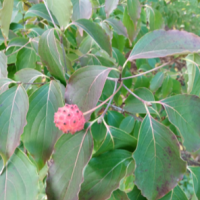
Leaf (summer)

Leaf (fall)
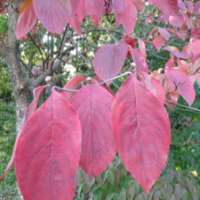
Winter Silhouette

Black Gum
Black Gum (Nyssa sylvatica)
Native to eastern North America, the nectar from these trees is collected by bees, which creates mild-tasting honey. Many Indigenous Peoples use various parts of black gum to treat wounds and numerous illnesses.
Full Tree

Bark

Leaf (summer)
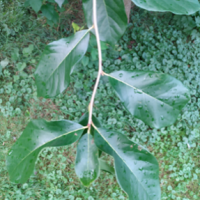
Tree (fall)
Winter Silhouette

Hoptree
Hoptree (Ptelea trifoliata)
The hoptree (species at risk in Ontario) is a native species of Ontario, New York to Florida, and West Coast to Minnesota. German immigrants in the 19th century used its seeds in place of hops in the beer-making process, giving the species its common name.
Full Tree
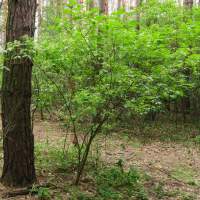
Flower
Samara Fruit

Leaf (summer)
Great Lakes
This category includes trees of the Great Lakes – St. Lawrence Forest Region. This forest extends along the St. Lawrence River, across central Ontario to Lake Huron, and west of Lake Superior along the border with Minnesota. It is known for its biodiversity and presents a mix of deciduous and coniferous forest that houses many hardwood tree species such as maple, oak, yellow birch, as well as white and red pine.2
American Beech
American Beech (Fagus grandifolia)
Native from New Brunswick west to Ontario and south to Florida and Texas. Birds and mammals like chipmunks and squirrels eat beechnuts from the tree. Early settlers ground the nuts into flour and used it for baking.
Full Tree
Bark

Leaf (summer)
Leaf (fall)
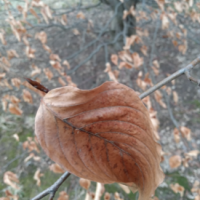
Winter Silhouette

Red Oak
Red Oak (Quercus rubra)
Native from Nova Scotia to Pennsylvania and west to Minnesota and Iowa. The acorns can be eaten by first shelling the nuts and then tying them up in a cloth and leaching them to remove bitterness. They can then be eaten whole or ground into a flour.
Full Tree

Bark

Leaf (summer)
Leaf (fall)

Winter Silhouette
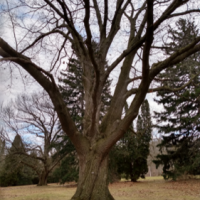
Eastern Hemlock
Eastern Hemlock (Tsuga canadensis)
Native from Nova Scotia to Minnesota to south along the mountains to Alabama and Georgia. The needles have been used to make tea that is high in vitamin C and tannins from the bark as a curative for diseases and for tanning leather.
Full Tree

Bark

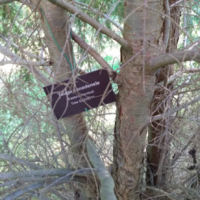
Cone
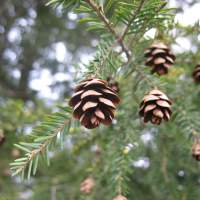

Needle
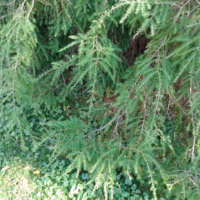
Winter Silhouette

Boreal
This category includes trees of the Boreal Forest Region. Located in the northern areas, it is the largest forest region in Canada, spanning from coast to coast, from Newfoundland and Labrador to the Yukon. Characterized by a cold climate and a low diversity of tree species, it still supports a diverse ecosystem of living organisms and is an essential contributor to healthy habitats for many wildlife species. It is densely populated by coniferous trees such as spruce, pine, and fir, with some deciduous tree species such as birch and poplar.3
Balsam Fir
Balsam Fir (Abies balsamea)
Native over a wide part of North America, especially in the higher altitudes from Labrador to Alberta to Pennsylvania. A favourite tree with its pleasant scent and long-lasting needles after it has been cut.
Full Tree
Bark
Needle

Cone

White (Paper) Birch
White (Paper) Birch (Betula papyrifera)
Native from Greenland to British Columbia, and south to Pennsylvania. Squirrels, yellow-bellied sapsuckers, and hummingbirds eat the sap. Many Indigenous Peoples make birchbark canoes by stretching the stripped bark over wooden frames. Birchbark is also used in quill box and medallion construction.
Full Tree

Bark
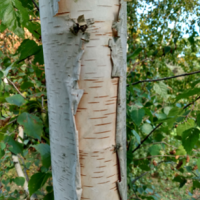
Fruit

Leaf (summer)

Leaf (fall)
Winter Silhouette

Larch/Tamarack
Larch/Tamarack (Larix sp.)
Native to northern North America and can be found as far north as the Arctic Circle. This tree received its name from the word Tamarack, which is the Algonquin name for the species and means "wood used for snowshoes”.
Full tree
Bark
Needle (summer)

Needle (fall)
Canada Wide
Canada includes several other forest regions in addition to the Carolinian, Great Lakes-St. Lawrence, and Boreal. Trees that are native to Canada, but are not specifically associated with those regions, are included in the Canada Wide category. For instance, the Douglas-fir is native to the Coast Forest Region of British Columbia. Also included, trees that are present through a wide area of the country, such as the Trembling Aspen, or overlapping onto other forest regions such as the Acadian Forest Region of New Brunswick and Nova Scotia, like the Eastern White Cedar.
Douglas-fir
Douglas-fir (Pseudotsuga menziesii)
Native along the Pacific coast to the inland mountains of the Pacific Northwest. Douglas-firs are among one of the largest and oldest trees in Canada and are considered one of the world's most important timber species.
Full Tree
Bark

Needle
Cone
Eastern White Cedar
Eastern White Cedar (Thuja occidentalis)
Native to Canada from Manitoba to the East Coast. Another name for cedar comes from the Latin word Arborvitae, meaning ‘tree of life’, which is fitting as the typical lifespan is 200 years. The wood has been and continues to be used to make canoes.
Full tree
Bark
Needle
Cone
Trembling Aspen
Trembling Aspen (Populus tremuloides)
Native from Labrador to Alaska, south to northern Mexico and lower California. Aspens are the first trees to grow after a forest fire and spread by sending up sprouts from their roots to form large stands.
Full Tree
Bark
Leaf (summer)
Leaf (fall)

North America
This category includes trees that are native to North America, but that are originating from outside Canada. Although coming from regions with a warmer climate, these non-native species can adapt and survive in our environment. With the event of climate change, it is anticipated that some tree species will be migrating north from their current native distribution range. Some can become invasive, such as the Black Locust. Other trees in this category include the Yellowwood and the Umbrella Magnolia.
Yellowwood
Yellowwood (Cladrastis kentukea)
Native to North Carolina, Kentucky and Tennessee. The tree is a pollinator plant that supports insects and birds. In spring the bees will visit the flowers for the nectar they produce. Early settlers used the tree's yellow heartwood (centre of the tree) for dyes.
Full Tree

Bark

Flower

Leaf (summer)

Leaf (fall)
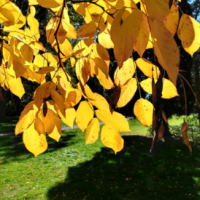
Winter Silhouette

Umbrella Magnolia
Umbrella Magnolia (Magnolia tripetala)
Native to the Eastern United States. The fruit produced by the Umbrella Magnolia is a source of food for birds and small mammals. The name of the tree comes from the way the leaves cluster at the tips of branches, forming an umbrella shape.
Full Tree
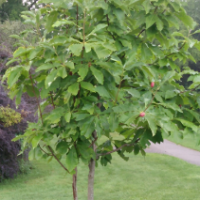
Bark

Flower

Fruit

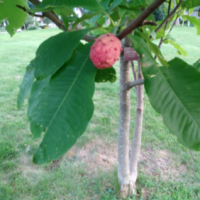
Leaf (summer)

Leaf (fall)

Winter Silhouette

Black Locust
Black Locust (Robinia pseudoacacia)
Native to the Southern Appalachian and the Ozarks. The black locust provides nesting cavities for woodpeckers, including hairy, downy and red-bellied woodpeckers and northern flickers. NOTE: Not recommended for planting as the species easily spreads and can takeover unmaintained areas.
Full Tree

Bark

Flower

Fruit
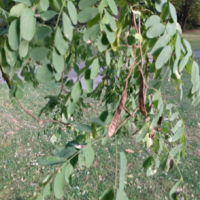
Leaf (summer)
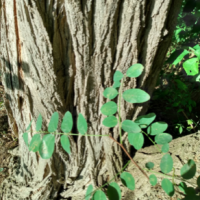
Winter Silhouette
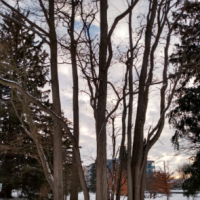
World
This category includes trees that originate from other areas of the world, such as Europe, Northern Africa and Asia. They are non-native to Canada, but able to adapt and grow in our climate. They are being planted in cities, along roads, in parks or private gardens, due to some unusual and attractive characteristics, such as form, foliage, flower or fruit. The English Columnar Oak is an example of a tree appreciated for its compact form. Some of the species of trees represented in this category have been around for millions of years, such as Ginkgo and Dawn Redwood.
Ginkgo
Ginkgo (Ginkgo biloba)
Native to eastern China, the Ginkgo tree is one of the oldest trees, growing on earth for 150 million years. Once the trees are at least 20 years of age, edible seeds are produced that have a good flavour and are used in East Asian cooking.
Full Tree

Bark

Fruit

Leaf (summer)

Leaf (fall)
Winter Silhouette

Dawn Redwood
Dawn Redwood (Metasequoia glyptostroboides)
This tall tree is native to central China. Dawn redwood is an ancient tree that lived millions of years ago at the same time as dinosaurs – when it was plentiful in North America and Greenland. The tree was known only as a fossil until it was rediscovered surviving in remote valleys.
Full Tree

Bark

Needle (summer)

Winter Silhouette

Columnar English Oak
Columnar English Oak (Quercus robur Fastigiata)
Native to Europe, North Africa and Western Asia, the variety ‘Fastigiata’ naturally grows into a column-like shape. This tree produces acorns that are a valuable source of food for small mammals and birds, although it can take up to 20 years before the first crop of acorns is produced.
Full Tree
Bark

Leaf (summer)
Winter Silhouette

Future
Currently the more prominent areas of the Graham Arboretum are the Memorial Tree Loop and the Conifer Loop. In the future, the City of London hopes to establish the other spaces of the arboretum and continue creating an inviting space for the public to learn more about trees.
This site includes text supplied by the Julia Hunter Fund.
